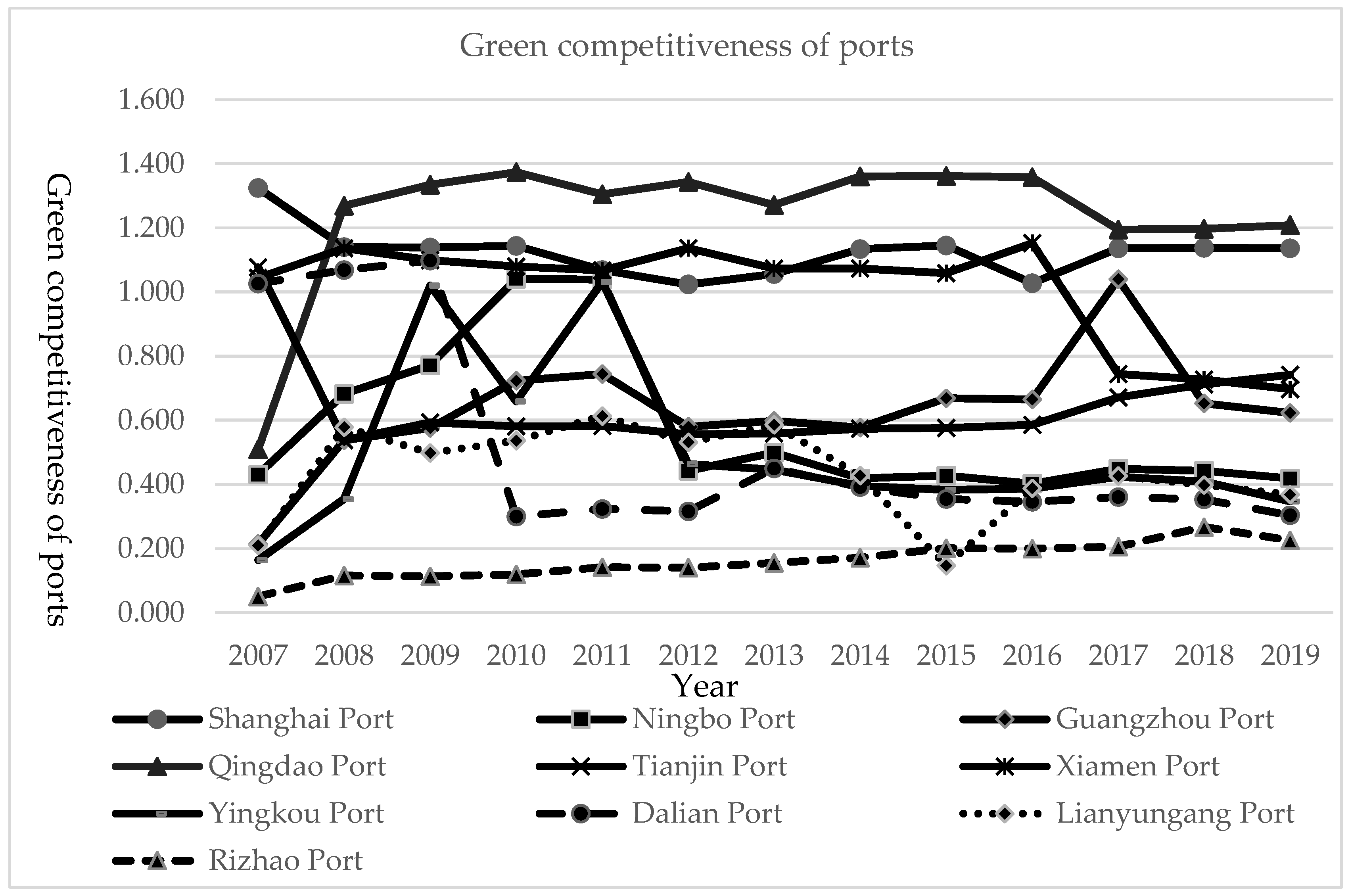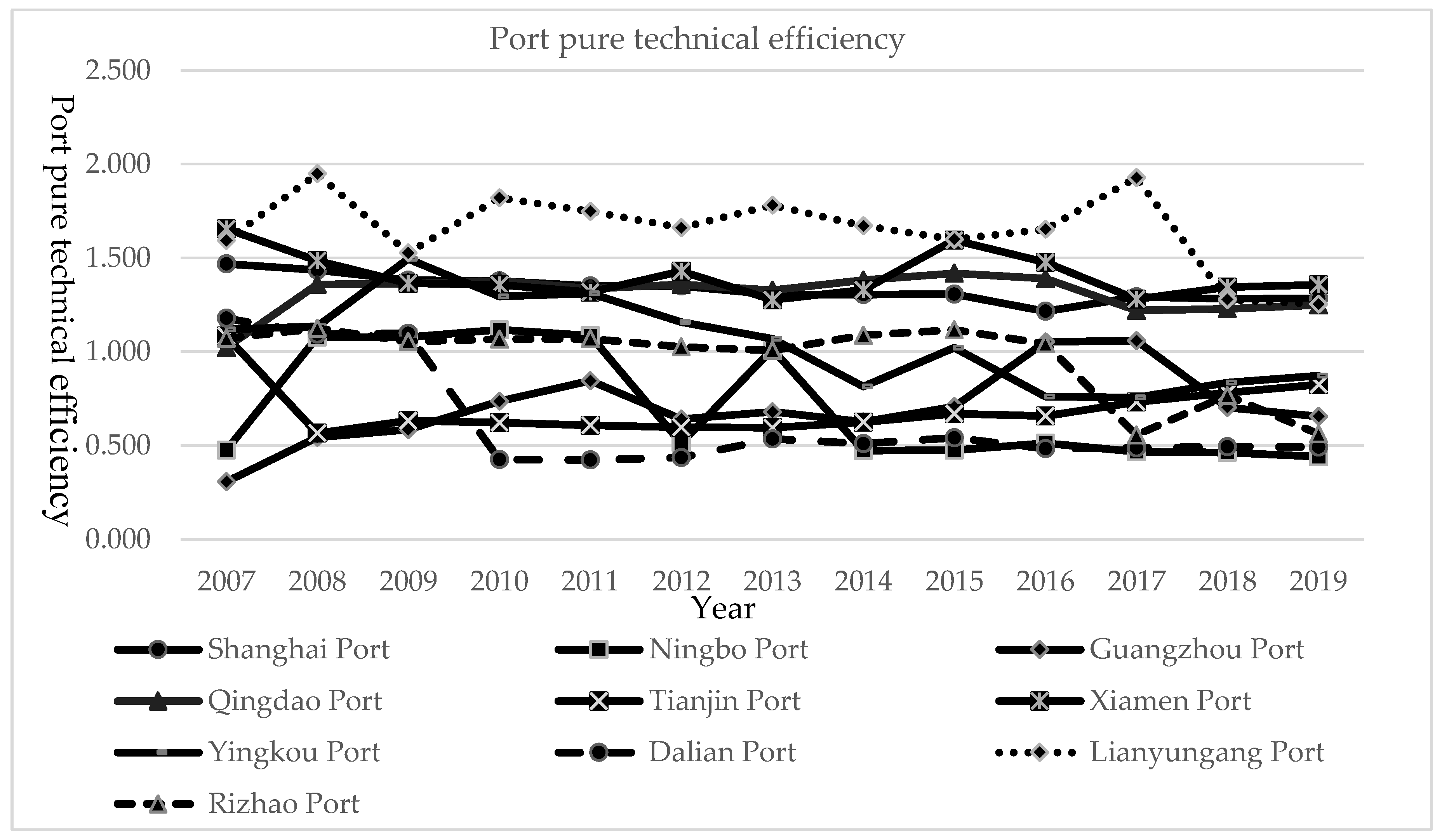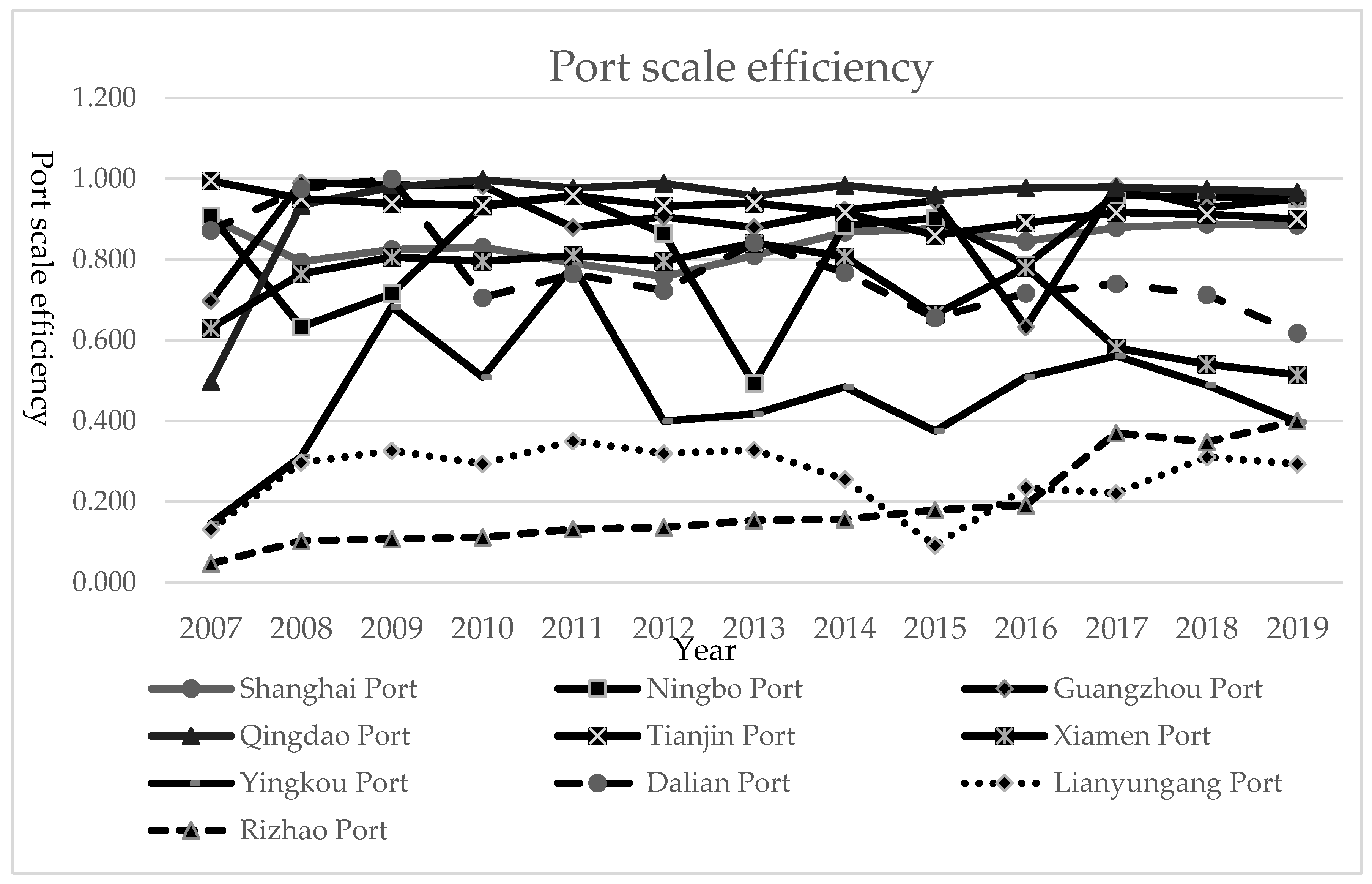6.1. Green Competitiveness Analysis of Ports
According to the evaluation results of port green competitiveness, it can be known that, from the perspective of time sequence, the green competitiveness of the top 10 ports is in a dynamic change and gradually becomes stable in 2017. The pure technical efficiency is stable and the gap between ports is small, indicating that technological improvement and upgrading is the cornerstone of green port development. Under the background of “double carbon”, Chinese ports actively build ecological green ports, and energy-saving and emission-reduction technologies, such as automatic rail cranes, new energy card collection, and oil-to-electricity conversion, have been applied in the production and operation of most ports. Port scale efficiency presents a polarization trend, but as time goes by, the gap between ports becomes smaller and scale efficiency gradually increases. This reflects the excessive investment in port infrastructure and scale in the pre-construction process of the port, resulting in the problem of investment redundancy, which makes the port scale and port green development unable to reach the optimal configuration. Due to different natural geographical conditions and the economic size of the hinterland, ports in China have different sizes, so port scale efficiency presents stratification. However, with the rapid development of cooperation between ports, information flow, and logistics, the conversion rate of port scale input gradually increases, and the scale efficiency gap between ports gradually narrows.
Based on the horizontal comparison of average values, the scale efficiency of Dalian Port, Ningbo Port, Guangzhou Port, and Tianjin Port is greater than the pure technical efficiency. In future development, these four ports should pay more attention to regulating input factors, developing and applying low-carbon emission reduction technology, improving port infrastructure, and improving resource utilization efficiency. The pure technical efficiency of Shanghai Port, Qingdao Port, Xiamen Port, Yingkou Port, Lianyungang Port, and Rizhao Port is greater than the scale efficiency. In the future, attention should be paid to the rational adjustment of port investment and construction scale and harbor industrial structure to promote the green development of ports.
6.2. Analysis of the Interaction between Port Green Competitiveness and the Hinterland Economy
According to the regression results of the panel data model, the relationship between port green competitiveness and the hinterland economy is not completely coordinated and promoted. There is a mutual influence and promotion relationship between port green competitiveness and hinterland economy, while there are also some factors that have a negative effect on port green competitiveness enhancement and hinterland economy development.
In terms of the role of the hinterland economy on the green competitiveness of ports, the total hinterland economy is an important support for the development of ports, and although the growth rate of China’s GDP has gradually slowed down in recent years, it is still an important factor in the improvement of the green competitiveness of ports. The increase in the total output of the hinterland economy is accompanied by the growth of global trade, which will further promote the increase in the direct income of ports. On the other hand, local budget revenue provides financial input for ports; supports port infrastructure construction and transformation; researches and applies low-carbon emission reduction technologies; and promotes ports to realize a virtuous cycle of energy saving, consumption reduction, carbon reduction, and efficiency increase. In terms of hinterland economic structure, with the accelerated implementation of China’s strategic economic restructuring and transformation and upgrading, the scale of tertiary industry gradually exceeds that of secondary industry, and the ratio of secondary industry added value gradually decreases. Especially in northern China, the secondary industry was once the dominant industry, and its decreasing proportion has affected the planning and construction of port infrastructure and transformation; the support role for the green construction of ports has gradually decreased or even become negative. Additionally, the tertiary industry in the three major industries in the proportion of increasing, in science and technology and education level driven and oriented gradually increased, not only conducive to the port to absorb foreign advanced science and technology and good management experience, optimize the trade structure. At the same time, it is also conducive to improve the quality of labor, enhancing the port’s technological innovation ability, realizing the transformation of traditional industries with modern science and technology, and enhancing the hard and soft strength of the port. In terms of the level of investment and consumption in the hinterland, during the 2007–2019 period, China’s economy has moved from high-speed development to high-quality development, and the growth rate of total fixed asset investment has also seen a steady decline with the gradual stabilization of economic development The trend is that the support for the green competitiveness of ports is not strong enough. Secondly, the local government’s excessive investment in port infrastructure construction at the early stage of port development. Although China has become the world’s largest port country, excessive investment has led to oversupply and blind expansion of ports, failing to bring into play the port scale effect, thus having a negative effect on the enhancement of port green competitiveness. Total social consumer goods refer to the amount of non-productive and non-operating physical goods sold directly by enterprises to individuals and social groups through transactions, as well as the amount of income obtained from the provision of food and beverage services. The goods transported by port vessels are usually bulk cargo, bulk grain groceries, containers, etc. Most of the goods are not sold directly by enterprises to end consumers, so they cannot be directly counted in the index. When the products produced by local enterprises meet the growing demand, correspondingly, the same type of goods imported and transported by the port will be reduced, thus having a negative effect on the green economic benefits of the port and hindering the improvement of the green competitiveness of the port. In terms of logistics accessibility between the port and the hinterland, waterway transportation, with its advantages of high load capacity, low cost, high efficiency, and environmental friendliness, promotes the green economic benefits of the port to improve the development of ports and hinterlands. The current road transport mode has the defects of high cost and environmental pollution, etc. The larger the road freight turnover, the corresponding increase in the cost and environmental pollution, so it has a certain negative impact on the green development of the port. On the other hand, road freight turnover includes other goods turnover except for port logistics, and there is a lack of road freight turnover records for port trade logistics, so the results obtained have a certain deviation, which has a negative impact on the green competitiveness of ports.
As for the role of the green competitiveness of ports on the hinterland economy, the improvement of green competitiveness of ports has a significant boosting effect on the total economic volume of the hinterland region, and the green development of ports is one of the important factors to promote the high-quality and healthy circular development of the hinterland economy. Waterway transport has a large cargo volume, low transportation cost, and is suitable for large-scale transportation, and these advantages have attracted a large number of developers and investors to the hinterland region, prompting the gathering and flow of capital in the hinterland region. Although road transportation is flexible, fast, and suitable for short- and medium-distance transportation, it also has small capacity, high energy consumption, and high pollutant emission, which is negatively limited to the interior of the port hinterland and combined with the positive advantages and negative defects of road transportation. Its negative effect is greater than the positive effect for the direct economic hinterland of the port, which weakens the economic growth capacity of the direct economic hinterland of the port. In the long run, it is not conducive to the healthy and sustainable development of the regional economy of the hinterland.
In order to achieve sustainable development of the port and the hinterland, in the future, the hinterland region should focus on adjusting the industrial structure, reasonably deploying the proportion of secondary and tertiary industries in the economic development of the hinterland region, and accelerating the formation of an industrial layout supported by high technology. Additionally, the hinterland region should promote the integration of port and hinterland resources, optimize the transport structure between the port and the hinterland, and give full play to the location advantages of the port to achieve healthy and coordinated economic development. In the post-epidemic era, in the face of the normalization of epidemic prevention and control, the government should increase support to help port enterprises cope with the adverse effects of the epidemic faster and more forcefully, namely through tax relief, helping port financing, and reducing the cost of green investment and construction for enterprises. During the epidemic period, under the dual influence of the decline in global trade volume and the upgrading of port capacity, the intensity of regional competition gradually strengthened. As a solid backing for port development, the hinterland should use the existing rich port resources as a basis to vigorously develop and build green and intelligent supply chain bases within the port area to create a more comprehensive node network base, enhance connectivity with ports, and improve core competitiveness. Ports with strong green competitiveness should combine with the industrial structure of the hinterland, business environment, and logistics services to further enhance their hard strength in green development and soft strength in trade services to maintain competitive advantages. The ports with weak competitiveness should take advantage of the economic structure of the hinterland and the financial support of the local government, as well as the cooperation between ports, to improve the sustainable development capacity of the ports. In the state of epidemic prevention and control, the port should accurately grasp the trend of waterway freight demand in the hinterland based on the analysis of changes in throughput during the epidemic period, adjust the cargo structure, and develop timely response routes to ensure that the port’s production capacity can proactively respond to changes in demand. Secondly, the port should improve the construction of the port consolidation and distribution system; do a good job of information interchange and capacity coordination between railroad, highway, waterway, and other modes of consolidation and distribution; and speed up the turnover of goods in port transportation efficiency.










